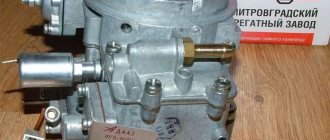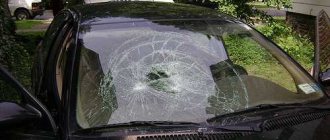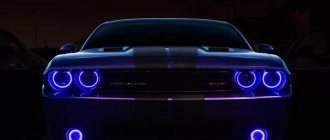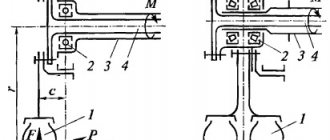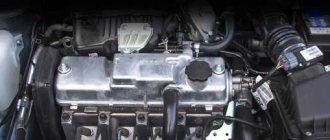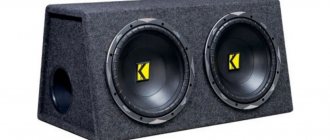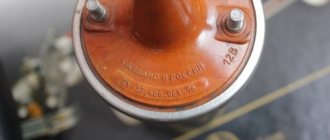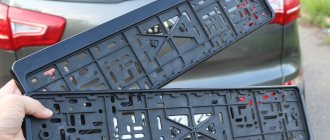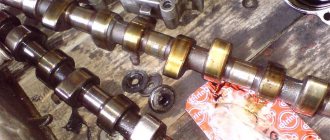When buying a car, the new owner always thinks about how to extend its service life and protect it from damage. Fans of trips out of town and active recreation suffer from this issue even more often, because the risk of damaging an SUV increases significantly when driving off-road. Today, there are a huge number of tuning options that allow you to strengthen the car body and help it drive on any route.
Snorkel - what is it?
The first equipment called “snorkel” appeared during the Second World War. They were equipped with submarines. Thanks to the new device, the submarine was able to extend its time under water. The main disadvantage of air intakes of that time was the inability to exhaust air. For this reason, there was not enough oxygen in the submarine, and it became difficult to be inside.
Snorkel - what is it? Many car enthusiasts ask a similar question. The snorkel (air intake) is a piece of equipment in the form of a pipe that rises along the front of the car body to the top. The purpose of its installation is to purify the air entering the engine, and it is also called a “device for operating the engine under water.”
Advantages and disadvantages of use
Experts identify the following aspects of the benefits of using the “trunk”:
- it effectively protects the car from water hammer when it is necessary to cross deep water or mud barriers,
- it significantly reduces the amount of dust entering the air filter system if the car is moving along a country, sandy path,
- having an attachment, it makes it possible to save, even in small amounts, fuel,
- It is equipped with an effective moisture removal system, allowing the car to feel confident in heavy rain conditions.
Among the disadvantages of a snorkel, many cite the fact that its installation significantly transforms the appearance of the car, mainly worsening the overall aesthetic impression. However, this, of course, is a matter of taste, since many motorists like the new design with a “trunk” more than without it.
A little history
The snorkels got their name in honor of the first and most famous manufacturer - Safari Snorkel. Equipment production was located in Australia. Here, the purpose of installing snorkels was to protect the engine from dirt and dust.
At the moment, the main function of the air intake is to protect the heart of the car from water entering in the first place.
Device
Snorkel - what is it? The snorkel device is a pipe that originates from the air filter and rises up to the hood and windshield.
The pipe of the device is connected to the air intake using sealed and dense rubber and plastic. This design increases the strength of the equipment and extends its service life.
Having determined the purpose of the installation and its structure, understand: “Snorkel - what is it?” - much simpler. Air intake tasks:
1. Cleaning the air from dirt and dust.
2. Dispersion of splashes and large raindrops.
Standard factory models are mounted significantly lower, so all the water and dirt coming from the wheels ends up in the engine. Such situations can lead to car breakdown, and repairing its main part will cost the owner a considerable amount.
Thanks to the modified design, snorkels make it easy to drive through holes filled with water and small rivers, because nothing threatens the car’s engine. A snorkel will also be useful on dusty sandy roads, because the upper location of the filter will save the engine from contamination.
How to make a snorkel with your own hands
It’s easy to make a homemade snorkel if you have the necessary materials and simple skills (the main thing is that your hands grow where you need them). To do this, you need to buy a pipe that will perform this function well.
Which pipe is suitable? If you have soldering skills, you can take a polypropylene pipe, which is easy to cut and provides good soldering. This is the so-called “sewer tuning,” as experienced car enthusiasts say.
Some manage to literally create an air intake using polyurethane foam, which looks very unusual.
A simpler option would be corrugation, which you may have seen in devices for blowing leaves from asphalt. Its diameter is approximately 65 mm in diameter. It is durable and reliable. Take at least 2 meters in length. You will also also need:
- Clamps with nuts or bolts. Choose according to your taste and color. You can find them at a plumbing supply store. They are usually used to secure sewer pipes.
- Rubber corrugation. It is needed to attach the snorkel to the air filter.
- Consumables: self-tapping screws, high adhesive sealant, rubber seal, mounting angles, cable ties.
What to look for when purchasing
When choosing a snorkel, you should pay attention to:
1. The quality of the materials used. Air intakes are typically used in difficult situations, so the risk of equipment damage is high. The connections of the parts must be rubberized. This improves fastening and increases the strength of the product.
2. Give preference to a model whose fasteners have anti-corrosion properties.
3. Pay attention to the nozzle. It is best if it has drainage. This increases the quality of the snorkel.
4. Choose a model with a rotating spout. In different situations, you can adjust the setting as needed.
How to choose equipment
As in any matter concerning the purchase of an important accessory for a car, you need to choose a snorkel very carefully, taking into account several key factors:
- under what conditions it will be used together with the machine. The choice of material from which the “trunk” is made and whether it provides reliable hermetic protection depends on these conditions. Also location by car,
- having clearly decided where exactly it will be installed, they consider options for its dimensions, snorkel dimensions,
- It is necessary to take into account the price point. Since the cost range of snorkels in the modern automobile market is very impressive. Thus, you can find amounts ranging from amounts that are quite affordable for a regular budget to impressive prices that only select motorists can afford.
Mounting and installation methods
Installing a snorkel involves attaching it to the front of the car body. The device reaches the level of the windshield and is mounted on a rack. There are two ways to direct the equipment spout:
1. In the direction of travel of the car.
2. Against the direction of travel of the SUV.
In the first option, the snorkel pipe and its nose are directed towards the air movement. This method is considered preferable because it allows the equipment to function correctly. The snorkel system provides for the process of free entry of dirt and dust into it, which is removed from it.
The second case involves turning the snorkel nose against the air flow. In such a situation, the likelihood of even more dirt and dust flying out from under the wheels of the SUV increases. In winter, there is a possibility of ice forming in the system, which will interfere with normal functioning.
Another incorrect option for installing equipment is to turn the snorkel nose towards the windshield. In such a situation, there is a possibility of water getting into the engine when passing a water obstacle (if the spout is close to the glass). The only possible option for this situation is moving through a forest, when the probability of a branch getting into the device’s nozzle is very high. To avoid damaging the mesh located at the top of the snorkel, the spout can be turned to the side.
Many cars have their own installation nuances. For example, a snorkel on a Niva is always installed on the right side. As a fastening, you can use a corrugation that connects to the air intake. Many off-road enthusiasts install a snorkel on the Niva. The car is unpretentious, durable and durable. Another SUV that is often equipped with a trunk is the Patriot. Its owners are not afraid of potholes and potholes, and by installing a snorkel on the Patriot, there is no need to be afraid of water obstacles.
Nozzles and their functions
Nozzles vary in type and function. The most common attachment is, perhaps, the “Gander”. It is a curved short tube that functions better if it is turned forward, against the direction of the machine. When the wind hits the air intake hole directly, a centrifuge effect is formed in the snorkel. Dust particles or drops of liquid in the flow cannot enter the air duct tube, and they have no choice but to settle in the drainage system and be discharged/flow into the side slots. By turning the “Gusak” in the other direction – sideways or backwards – the nozzle can work the other way around, that is, it can begin to absorb all those particles that it is supposed to protect against. Dirt will not be thrown towards the walls, since the suction speed will not allow it, so it will fly directly into the filter without entering the drainage system.
The Gusak should be turned forward only in one case: if there is a blizzard or heavy snow outside - these large particles cannot be easily thrown away due to their large weight. Also, as an exception, the snorkel is turned inward. This is done when driving through a forest or in an area where tall plants grow. Unscrew the nozzle in order to maintain the device in the required condition and its location.
The next attachment is called “Cyclone”. Its operating principle is the same as that of “Gusak”, only it is capable of better cleaning quality. The air flow with contaminants is sucked into the “barrel” of the cyclone from below and distributed along the walls. Dirt and water particles come out through the drainage holes.
It is worth noting that for its best operation, the Cyclone must be cleaned periodically.
Drivers who use this type of attachment note a loss of efficiency and some noise. This is due to suction resistance.
Advertisement
Leak test
After installation of the equipment is completed, it is recommended to carry out a leak test. All you need is a new plastic bag. Start the engine, remove the nozzle and place the bag over the snorkel. The correct reaction of the equipment will be a bursting bag. If the package is sucked into the air intake, then it is worth checking the installation again.
Popular questions and conclusions
Which nozzle is better? Each car owner chooses it according to his own taste and color. But in practice, to drive on dusty roads you need to use the Cyclone, and in the city it is replaced with the Gusak.
What happens if water gets into the air intake when washing a car? Oddly enough, even after automatically washing the car with a snorkel, the air filter remains completely dry. There is also an opinion that if you start the engine and spray it directly into the “gander”, the water will not reach the cylinders, but it’s better not to do this.
How can a plastic snorkel be reliable? If you install the device correctly, both cheap and expensive snorkels will work equally well.
Is it convenient to travel with a snorkel? When installing an air intake device, visibility may deteriorate, but only by a very small extent.
Homemade snorkel
Very often, car owners decide to save money and prefer to make the equipment themselves.
To make your own you will need:
1. Pipe.
2. Corrugation.
3. Rubber or plastic corners.
4. Fasteners (for example, a clamp).
5. Special sealant.
The size of the pipe largely depends on the model of your car. Pay attention to options with a diameter of 70-75 mm. This size is perfect for UAZ cars, but for Niva it is better to choose a smaller diameter (50 mm).
The design of the snorkel is simple, but if you make a mistake, you can lose the car’s engine.
Design and operating principle
The design of the snorkel is extremely simple; it consists of a pipe-body and an air intake nozzle. The nozzle is connected to the body by a connector made of dense, reliable rubber; flexible plastic is also used for this connection. Rubber or plastic helps to ensure an airtight seal even in situations where permanent powerful body vibrations are recorded while driving on a poor-quality road with obstacles.
The principle of operation of the nozzle is equally simple. It has two main functions:
- ensure the delivery of clean air to the engine, free of any dust or dirt,
- The snorkel works as a kind of separator that filters out water splashes and raindrops that enter the snorkel. Therefore, it is made from anti-corrosion materials.
Manufacturers and prices
The most reliable and trusted manufacturers of air intakes are the Australian companies Safari and Airteck. There are lesser-known foreign brands that are famous for their quality (Airflow Snorkels), but do not have representative offices in the Russian Federation. To purchase their products you will have to order online. Mantec produces high-quality and durable products.
As for Chinese goods, their choice is not so great. Taking into account delivery, ordering online will cost a considerable amount, so the benefit will be minimal. If the price difference is small, is it worth choosing a lower quality product? You decide.
Problems associated with using a snorkel
As domestic practice has shown, the use of a snorkel is sometimes accompanied by undesirable technical and other problems. If, for example, such a “trunk” is made of plastic that is not resistant to low temperatures, in winter it may not withstand frost and burst, breaking the seal. If it is extended outside the vehicle (and this often happens), it can be damaged by tree branches and other foreign objects while driving.
The use of a “trunk” with an insufficient cross-section can also have a negative effect, since it will not be able to provide access to the required amount of air into the engine and, as drivers say, will begin to “choke” it. Ill-proper installation will lead to the fact that in heavy rain, water can directly enter the engine.
Drivers also often ask whether the “trunk” should be legalized, how it is registered, and whether it needs to be registered at all. This is the situation here. Since the installation of the device, being a structural change to the vehicle, does not affect traffic safety, there is no need to register it. Which, however, does mean that someday one of the traffic police officers will not take a principled position on this matter with the driver, and they will have to defend their innocence. Let your car's snorkel always bring you only benefits, but not problems!
